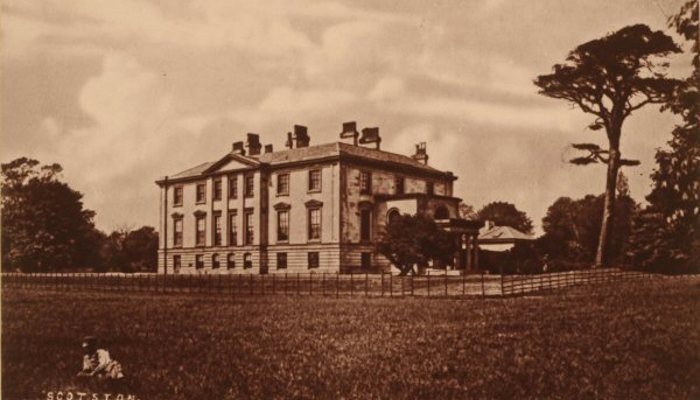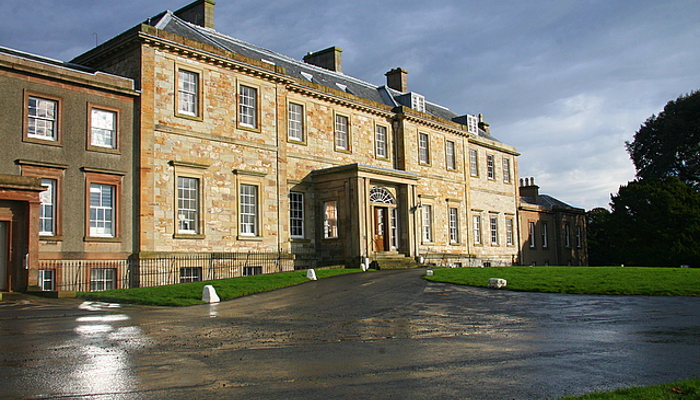
Inheritance and Privilege – Alexander Oswald of Changue

Alexander Oswald of Changue, 1777-1821
2849
Images © CSG CIC Glasgow Museums Collection
7th October 2020
Among the many paintings in Glasgow Museums’ collection is a portrait by Andrew Geddes, of his friend, Alexander Oswald. Oswald was an advocate, or barrister, and landowner, and born into the Oswald family dynasty of merchants, MPs and propertied gentlemen.
 The Oswalds had been established in Glasgow as colonial merchants and ship owners since the early 1700s and owned numerous estates including Scotstoun, Shieldhall, Moore Park, Whiteinch, Auchincruive in Ayrshire as well as urban properties in Virginia Street, Duke Street and the Stockwell in Glasgow. Their business partnerships traded in goods produced by enslaved people such as sugar, tobacco and madeira wine. In Glasgow they invested in local industries that also thrived on the slavery economy – sugar refineries, rope manufacturing (for shipping) and glassworks (making bottles for rum).
The Oswalds had been established in Glasgow as colonial merchants and ship owners since the early 1700s and owned numerous estates including Scotstoun, Shieldhall, Moore Park, Whiteinch, Auchincruive in Ayrshire as well as urban properties in Virginia Street, Duke Street and the Stockwell in Glasgow. Their business partnerships traded in goods produced by enslaved people such as sugar, tobacco and madeira wine. In Glasgow they invested in local industries that also thrived on the slavery economy – sugar refineries, rope manufacturing (for shipping) and glassworks (making bottles for rum).
Born in Scotstoun in 1777 Alexander was the youngest son of tobacco merchant George Oswald and his wife Margaret Smyth. Here, young Alexander grew up in the lap of one of the wealthiest merchant families of the day. His father headed a large colonial trading company, Oswald, Dennistoun & Co, and the profits from this business ensured that Alexander and his family lived an affluent life.
Images


Further wealth came to George Oswald in the form of the vast Auchincruive estate in Ayrshire. This he inherited from his uncle, Richard Oswald (c.1705-1784), the London-based international merchant and slave trader. Owner of several slave trading ships and a partner in the Bance Island slave trading fort in Sierra Leone, Richard Oswald had amassed a huge personal fortune trading in human beings. On his death in 1784, that wealth passed to George Oswald, and in turn to George’s sons and daughters.
Alexander’s older brother, Richard Alexander Oswald who would go on to inherit Auchincruive, was also the co-owner of two plantations in Jamaica and the 355 enslaved people attached to them. In 1835 he, his wife and members of her family were awarded compensation by the British state for the loss of their enslaved ‘property’ when slavery was abolished.
The Oswald family fortune allowed Alexander to buy three estates in Ayrshire – Changue, Cairn and Drummurchie. Now a landed gentleman in his own right, although not involved in the family business, he moved in the same social circles as most of the other merchant sons in Glasgow. From 1816, still unmarried, he would attend a ‘convivial club’ along with the likes of James Dennistoun (his brother-in-law), Robert Houston, Robert Dunmore and Kirkman Finlay. Nominally a ‘Whist and Supper Club’ it also seems to have involved consuming large quantities of Madeira, Port, Champagne, rum punch, porter, ale and snuff.
Maybe he left all of that behind in 1819 when he married into another property-owning family, the Hamilton-Dalrymples. His wife, Anne Hamilton-Dalrymple, was the daughter of Sir Hew Hamilton-Dalrymple of Bargany and North Berwick. She died along with their infant son a little over a year later, at the home of her brother-in-law, Viscount Duncan (later Earl of Camperdown). The following spring Alexander wrote to his wife’s family that he had gone to Bath to take the waters. Two weeks later he died there.
Alexander Oswald’s own story is not perhaps one of unimaginable riches and profitable colonial business ventures. Unlike his brother, he was not himself directly complicit in the exploitation of enslaved people, as far as we know. He did not trade in human beings like his great-uncle, or in slave-produced goods like his father. However, he personifies the privilege and generational wealth that flowed to those who made money off slavery. That wealth bred wealth, opened doors and made Alexander’s affluent lifestyle possible. His portrait is the legacy of that privilege.
Katinka Stentoft Dalglish,
Curator of Archaeology
